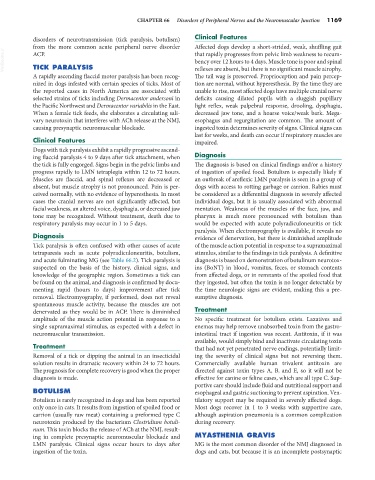Page 1197 - Small Animal Internal Medicine, 6th Edition
P. 1197
CHAPTER 66 Disorders of Peripheral Nerves and the Neuromuscular Junction 1169
disorders of neurotransmission (tick paralysis, botulism) Clinical Features
from the more common acute peripheral nerve disorder Affected dogs develop a short-strided, weak, shuffling gait
VetBooks.ir ACP. bency over 12 hours to 4 days. Muscle tone is poor and spinal
that rapidly progresses from pelvic limb weakness to recum-
TICK PARALYSIS
reflexes are absent, but there is no significant muscle atrophy.
A rapidly ascending flaccid motor paralysis has been recog- The tail wag is preserved. Proprioception and pain percep-
nized in dogs infested with certain species of ticks. Most of tion are normal, without hyperesthesia. By the time they are
the reported cases in North America are associated with unable to rise, most affected dogs have multiple cranial nerve
selected strains of ticks including Dermacentor andersoni in deficits causing dilated pupils with a sluggish pupillary
the Pacific Northwest and Dermacentor variabilis in the East. light reflex, weak palpebral response, drooling, dysphagia,
When a female tick feeds, she elaborates a circulating sali- decreased jaw tone, and a hoarse voice/weak bark. Mega-
vary neurotoxin that interferes with ACh release at the NMJ, esophagus and regurgitation are common. The amount of
causing presynaptic neuromuscular blockade. ingested toxin determines severity of signs. Clinical signs can
last for weeks, and death can occur if respiratory muscles are
Clinical Features impaired.
Dogs with tick paralysis exhibit a rapidly progressive ascend-
ing flaccid paralysis 4 to 9 days after tick attachment, when Diagnosis
the tick is fully engorged. Signs begin in the pelvic limbs and The diagnosis is based on clinical findings and/or a history
progress rapidly to LMN tetraplegia within 12 to 72 hours. of ingestion of spoiled food. Botulism is especially likely if
Muscles are flaccid, and spinal reflexes are decreased or an outbreak of areflexic LMN paralysis is seen in a group of
absent, but muscle atrophy is not pronounced. Pain is per- dogs with access to rotting garbage or carrion. Rabies must
ceived normally, with no evidence of hyperesthesia. In most be considered as a differential diagnosis in severely affected
cases the cranial nerves are not significantly affected, but individual dogs, but it is usually associated with abnormal
facial weakness, an altered voice, dysphagia, or decreased jaw mentation. Weakness of the muscles of the face, jaw, and
tone may be recognized. Without treatment, death due to pharynx is much more pronounced with botulism than
respiratory paralysis may occur in 1 to 5 days. would be expected with acute polyradiculoneuritis or tick
paralysis. When electromyography is available, it reveals no
Diagnosis evidence of denervation, but there is diminished amplitude
Tick paralysis is often confused with other causes of acute of the muscle action potential in response to a supramaximal
tetraparesis such as acute polyradiculoneuritis, botulism, stimulus, similar to the findings in tick paralysis. A definitive
and acute fulminating MG (see Table 66.2). Tick paralysis is diagnosis is based on demonstration of botulinum neurotox-
suspected on the basis of the history, clinical signs, and ins (BoNT) in blood, vomitus, feces, or stomach contents
knowledge of the geographic region. Sometimes a tick can from affected dogs, or in remnants of the spoiled food that
be found on the animal, and diagnosis is confirmed by docu- they ingested, but often the toxin is no longer detectable by
menting rapid (hours to days) improvement after tick the time neurologic signs are evident, making this a pre-
removal. Electromyography, if performed, does not reveal sumptive diagnosis.
spontaneous muscle activity, because the muscles are not
denervated as they would be in ACP. There is diminished Treatment
amplitude of the muscle action potential in response to a No specific treatment for botulism exists. Laxatives and
single supramaximal stimulus, as expected with a defect in enemas may help remove unabsorbed toxin from the gastro-
neuromuscular transmission. intestinal tract if ingestion was recent. Antitoxin, if it was
available, would simply bind and inactivate circulating toxin
Treatment that had not yet penetrated nerve endings, potentially limit-
Removal of a tick or dipping the animal in an insecticidal ing the severity of clinical signs but not reversing them.
solution results in dramatic recovery within 24 to 72 hours. Commercially available human trivalent antitoxin are
The prognosis for complete recovery is good when the proper directed against toxin types A, B, and E, so it will not be
diagnosis is made. effective for canine or feline cases, which are all type C. Sup-
portive care should include fluid and nutritional support and
BOTULISM esophageal and gastric suctioning to prevent aspiration. Ven-
Botulism is rarely recognized in dogs and has been reported tilatory support may be required in severely affected dogs.
only once in cats. It results from ingestion of spoiled food or Most dogs recover in 1 to 3 weeks with supportive care,
carrion (usually raw meat) containing a preformed type C although aspiration pneumonia is a common complication
neurotoxin produced by the bacterium Clostridium botuli- during recovery.
num. This toxin blocks the release of ACh at the NMJ, result-
ing in complete presynaptic neuromuscular blockade and MYASTHENIA GRAVIS
LMN paralysis. Clinical signs occur hours to days after MG is the most common disorder of the NMJ diagnosed in
ingestion of the toxin. dogs and cats, but because it is an incomplete postsynaptic

